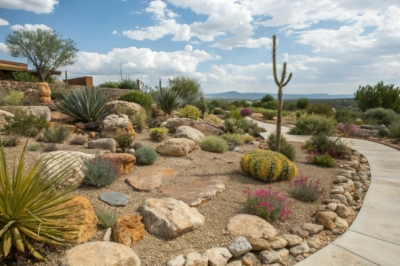1. Rocky Garden Edges
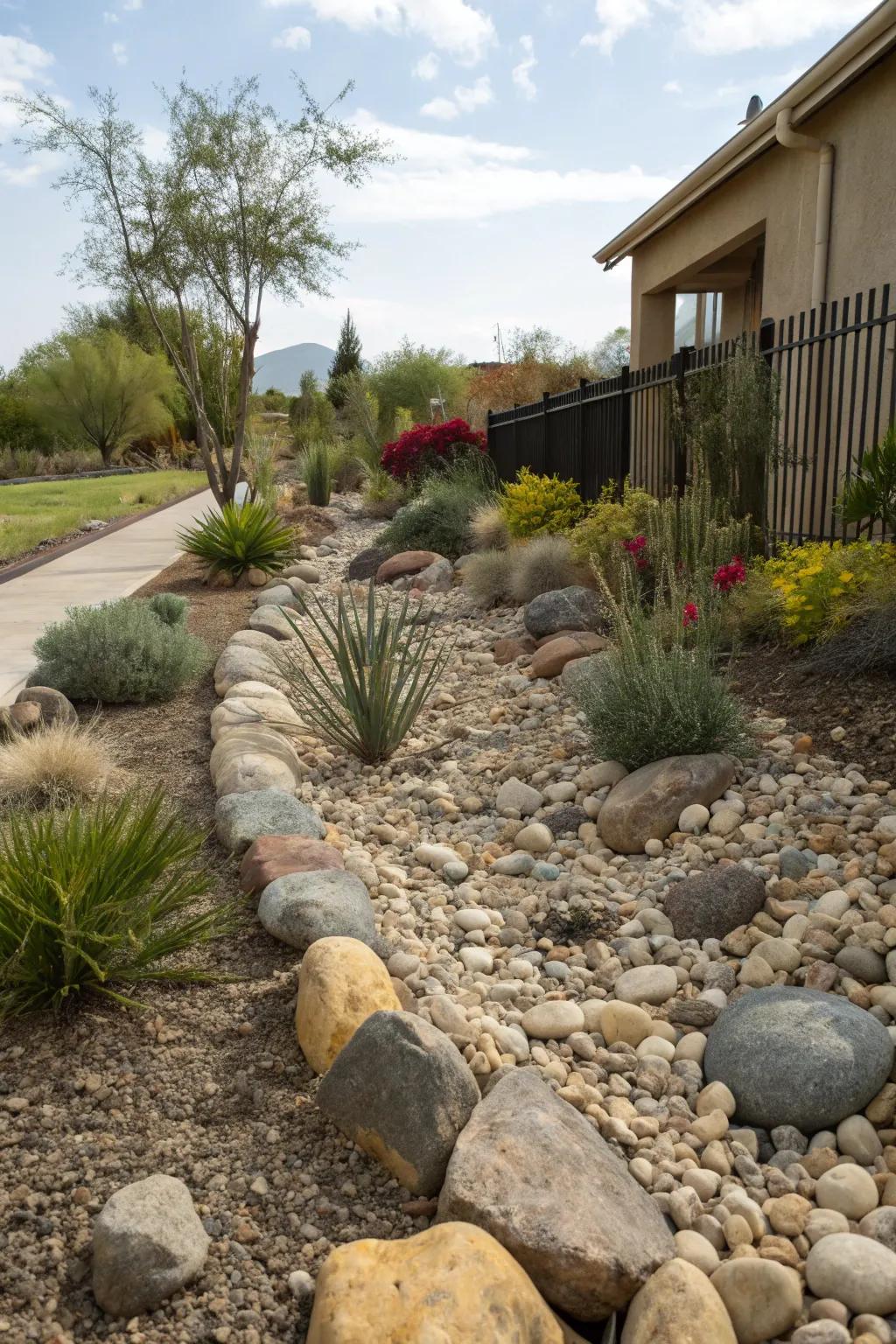
Use rocks to define garden edges, keeping plants in check while adding a rustic touch. My garden’s edges are lined with river stones, giving a polished finish.
Some ideas to consider:
- River Stones for Landscaping: Enhance your garden’s edges with smooth river stones, adding a natural, polished finish.
- Garden Edging Tools: Easily define garden spaces with high-quality tools, perfect for maintaining rock edge gardens.
- Landscape Fabric: Prevent weed growth under your stones with durable landscape fabric, ensuring a clean finish.
2. Contrasting Textures
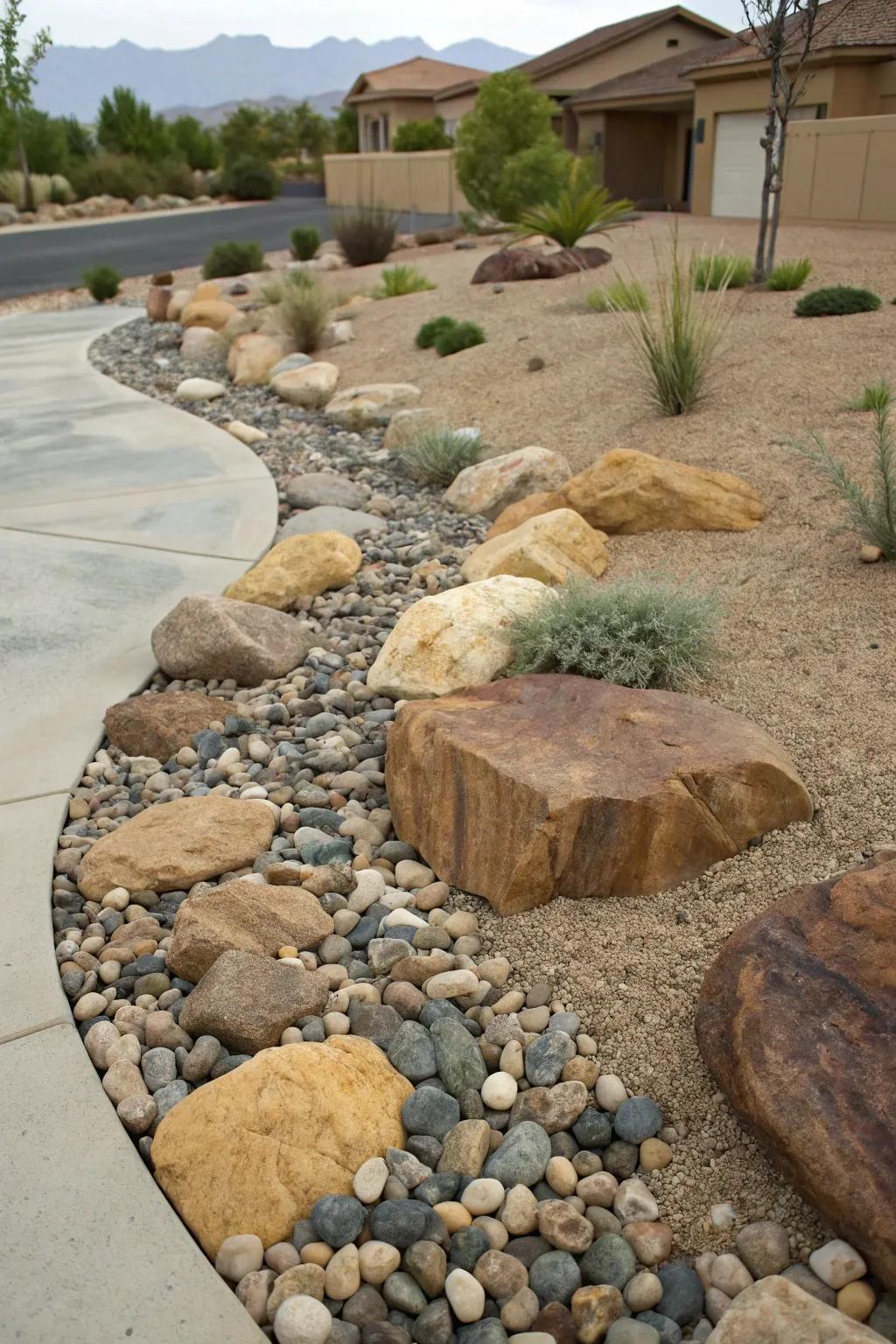
Mixing smooth pebbles with jagged stones creates a dynamic and interesting landscape. It’s a simple trick I use to make my garden visually engaging.
May just do the trick:
- Smooth River Pebbles: Enhance your garden with smooth river pebbles for a polished, natural aesthetic.
- Jagged Landscaping Rocks: Add dynamic texture to your garden using jagged rocks for a rugged, striking look.
- Garden Landscape Edging: Define your space with landscape edging for a clean, professional garden layout.
3. Rocky Fire Pits
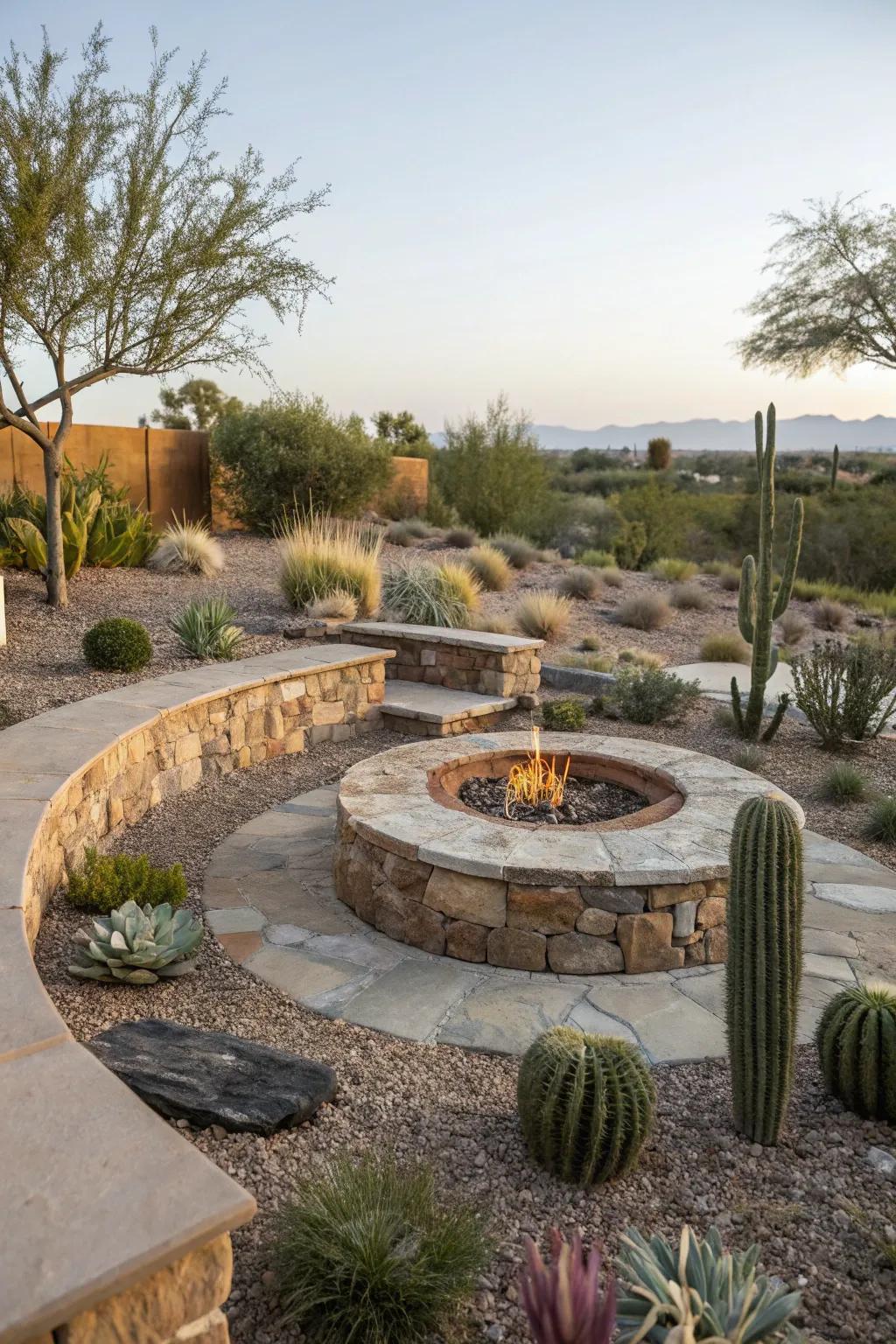
Build a fire pit with surrounding rocks for cozy gatherings. I’ve crafted a circular stone fire pit that serves as a perfect gathering spot for cool evenings.
Explore these options:
- Fire Pit Kit: Enhance your evenings with this durable fire pit kit, perfect for any outdoor setting.
- Heat-Resistant Outdoor Cushions: Add comfort to your fire pit area with these stylish and heat-resistant outdoor cushions.
- Decorative Lava Rocks: Elevate your fire pit’s aesthetic with these high-quality, decorative lava rocks.
4. Mulch and Ground Cover

Using gravel as a ground cover not only retains moisture but also adds contrast to the greenery. I often opt for a light-colored gravel that keeps my garden looking bright and tidy.
Useful items to consider:
- Decorative Gravel Stones: Brighten your garden while retaining moisture with these easy-to-install decorative gravel stones.
- Landscape Fabric: Prevent weed growth effectively by placing durable landscape fabric beneath your chosen ground cover.
- Garden Rake for Gravel: Keep your gravel tidy and evenly spread with this specially designed garden rake.
5. Gravel Seating Areas
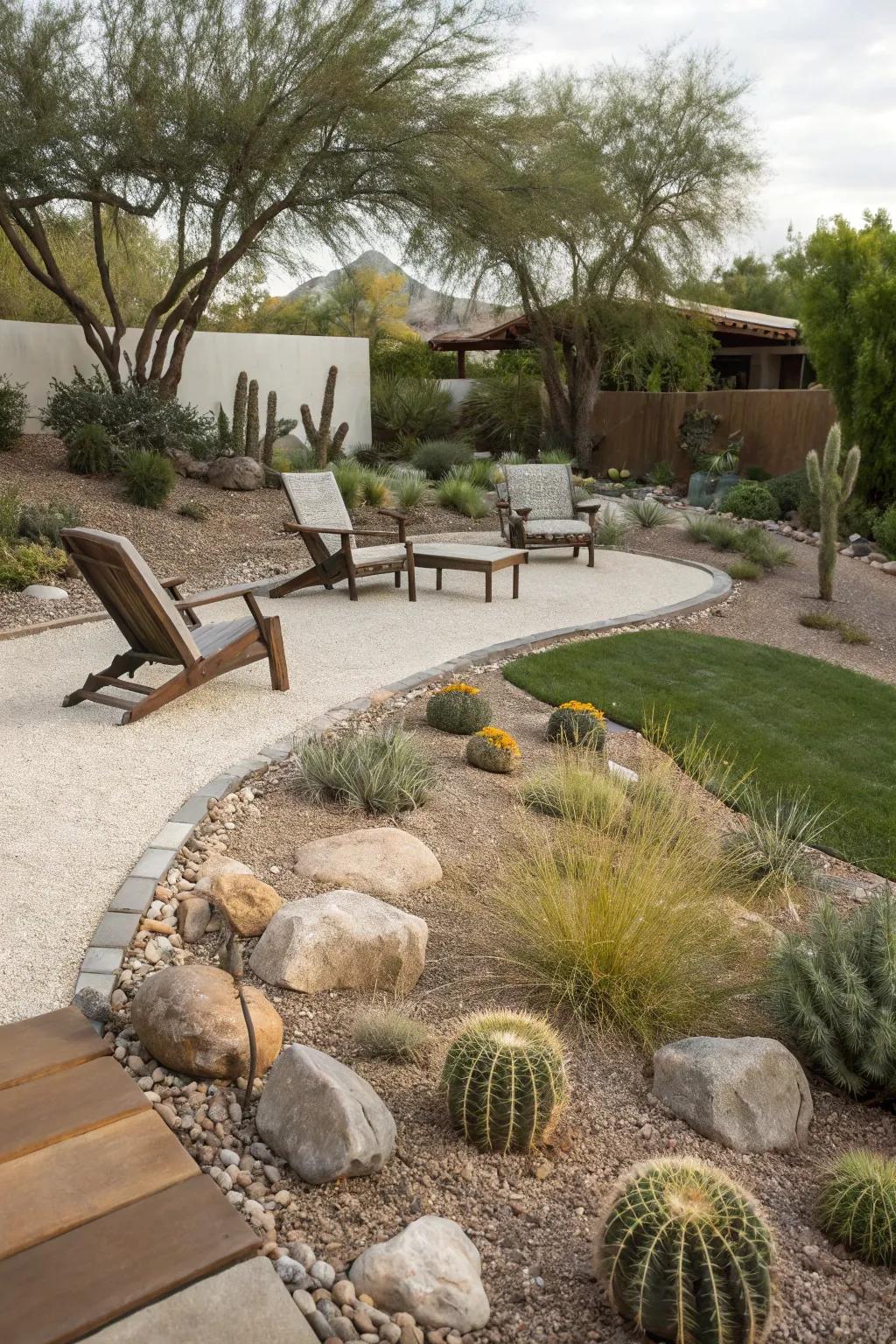
Create cozy seating areas using gravel as a base, which blends seamlessly with the surrounding rock landscape. I love how this setup invites relaxation and conversation.
Some handy options:
- Outdoor Adirondack Chairs: Enhance your outdoor seating area with comfortable and durable Adirondack chairs for ultimate relaxation.
- Patio Side Table: Add a practical touch with a sturdy side table perfect for drinks and snacks.
- Decorative Outdoor Gravel: Create a seamless and inviting base for your seating area with decorative outdoor gravel.
6. Rocky Water Features
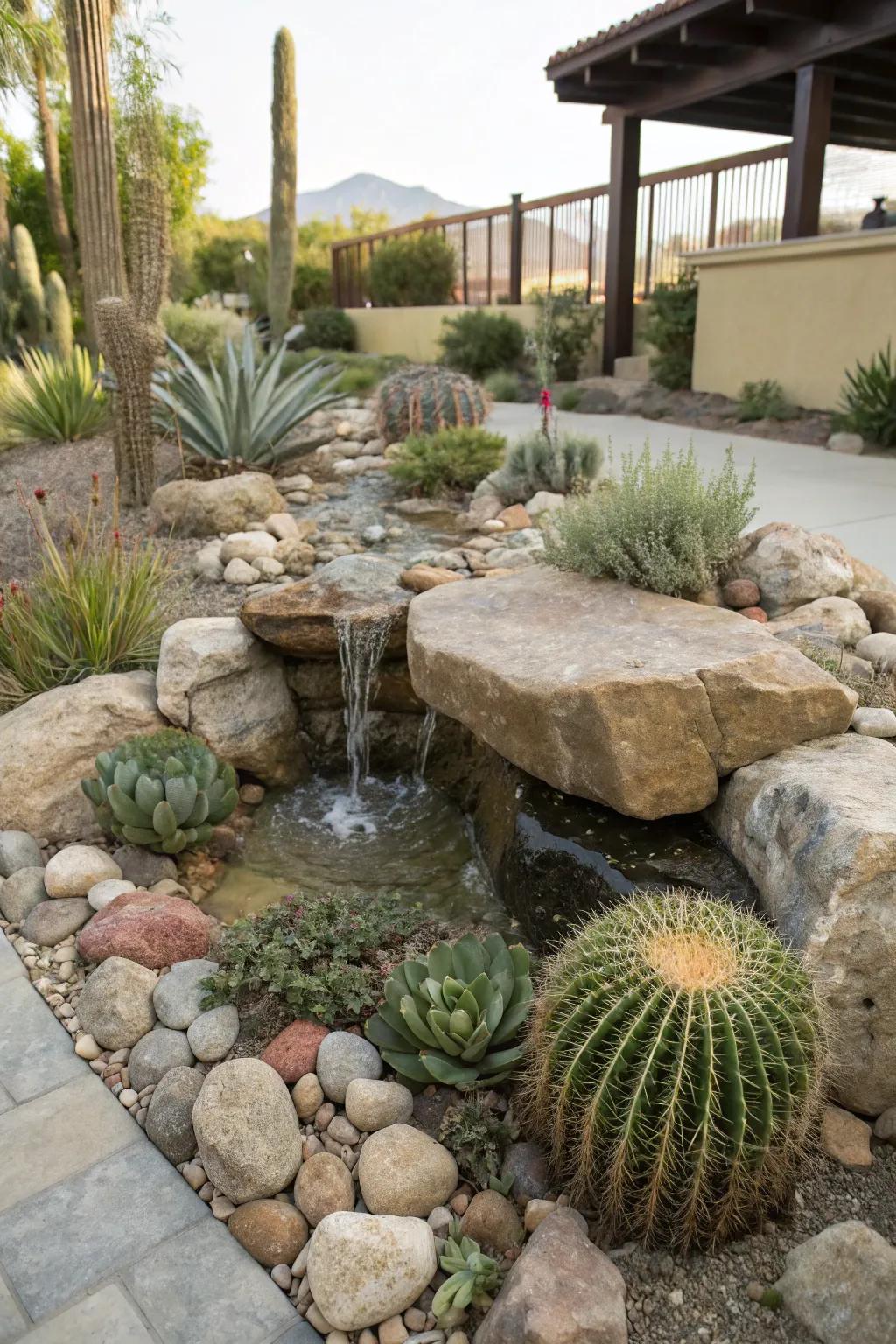
Incorporate a small water feature with rocks to add sound and movement. A bubbling rock fountain in my yard brings a refreshing feel, even in the heat.
You might like:
- Outdoor Rock Fountain Kit: Transform your space with a soothing rock fountain, bringing movement and tranquility to your yard.
- Submersible Water Pump for Fountains: Ensure continuous water flow in your feature with an efficient submersible water pump for fountains.
- Decorative Natural River Rocks: Enhance your water feature’s aesthetics with natural river rocks for a more authentic look.
7. Stepping Stones
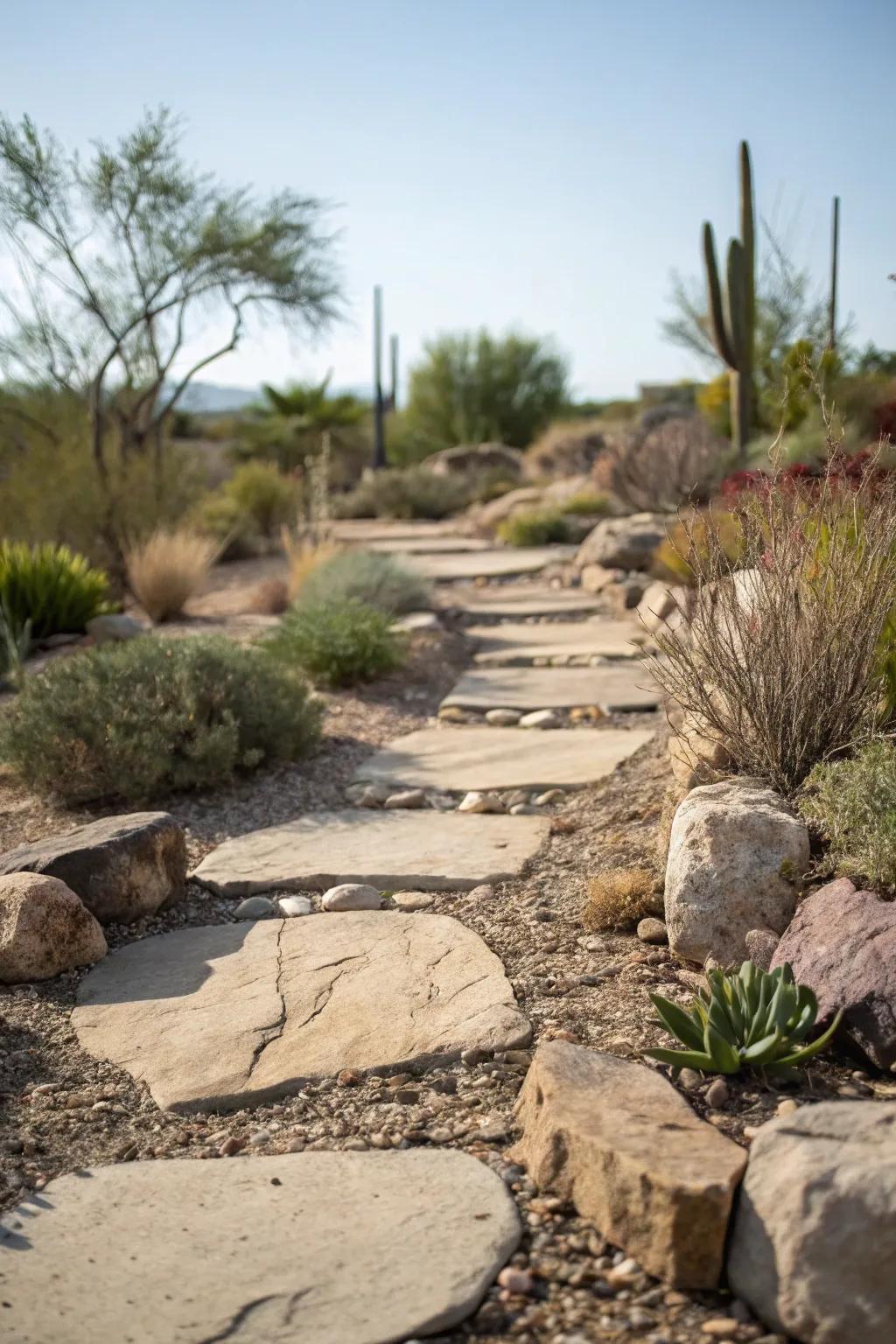
Lay down stepping stones to create pathways without disrupting the natural landscape. I’ve found that irregularly shaped stones lead to a more organic look.
Check these products out:
- Irregular Shaped Stepping Stones: Enhance your path with natural-looking, irregular shapes for a truly organic landscape design.
- Sandstone Stepping Stones: Add rustic beauty with durable sandstone stepping stones, perfect for desert-inspired xeriscapes.
- Flagstone Pathway Stones: Lay down flagstone for a textured, earthy look that complements xeriscape environments beautifully.
8. Rocky Retaining Walls
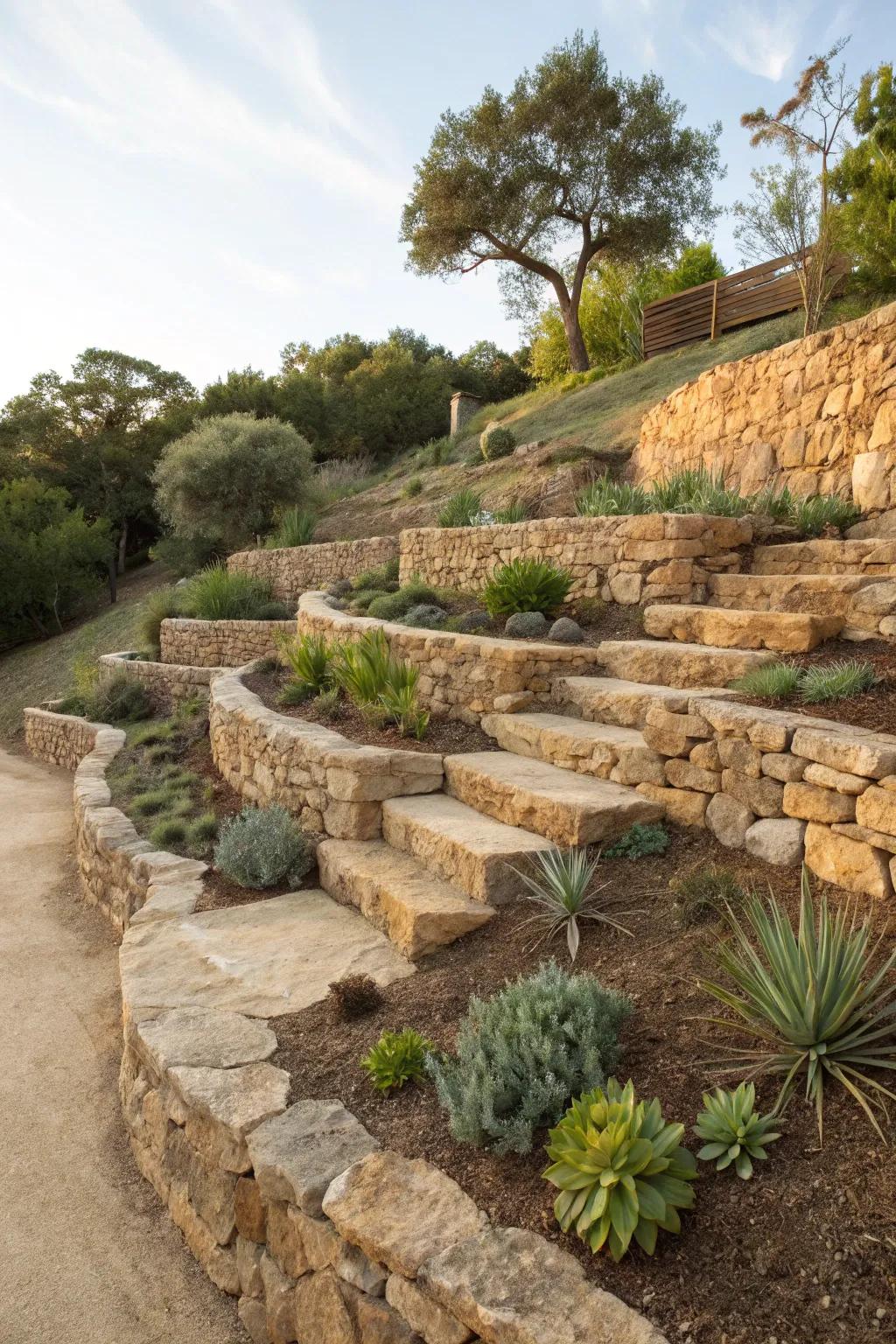
Use rocks to build retaining walls that can help manage slopes and add structure. My backyard has a few gentle terraces supported by natural stone walls, which are both practical and elegant.
These products might help:
- Natural Stone Retaining Wall Kit: Transform your garden with a natural stone wall kit, adding both function and charm.
- Landscape Fabric: Ensure durability and control weeds with premium landscape fabric beneath your stonework.
- Garden Edging Tools: Achieve clean lines and precise edges with quality garden edging tools for your stone walls.
9. Defined Borders
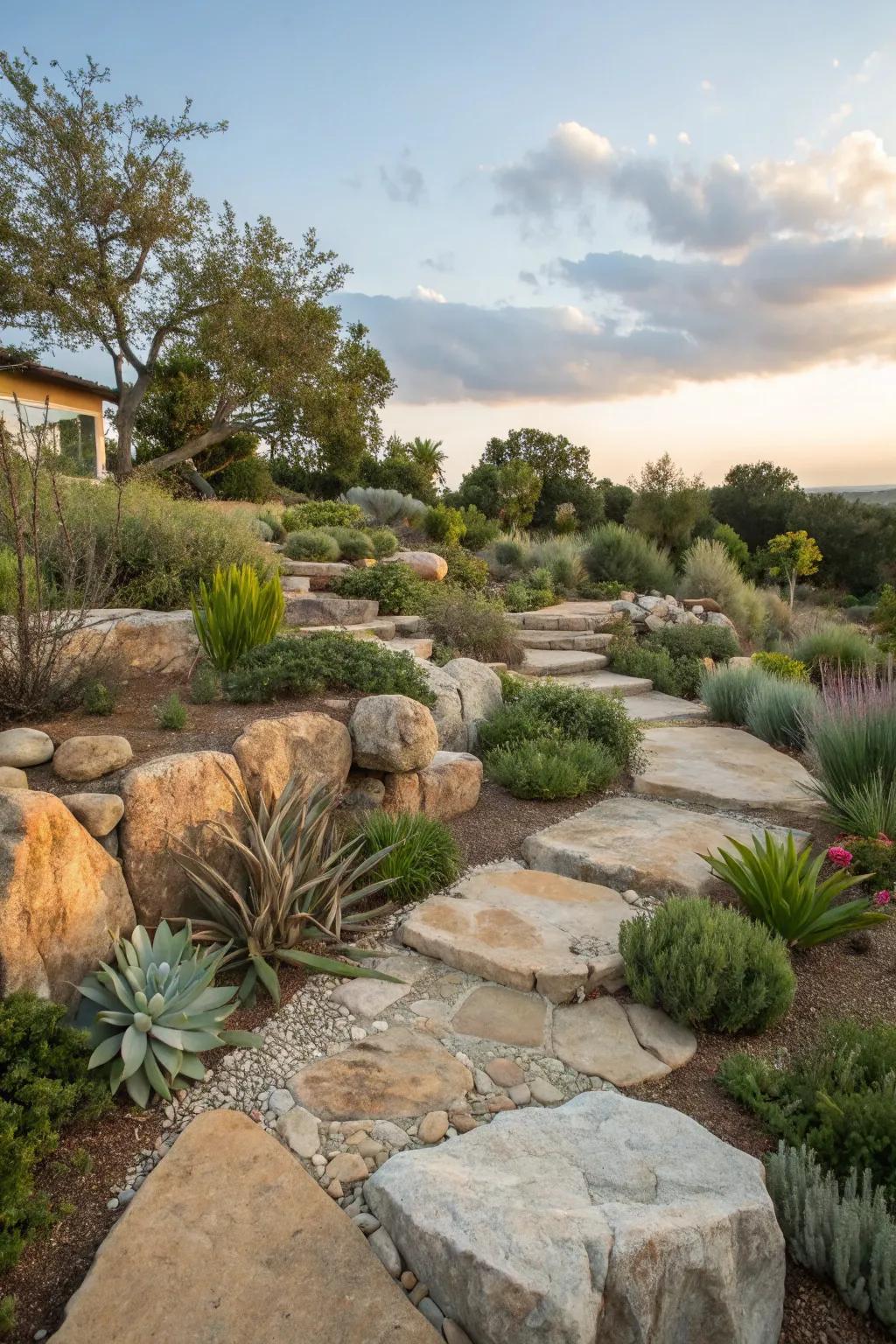
Use rocks to define the edges of your planting areas for a neat, structured look. I find that edging with larger stones keeps everything in place and looks professional.
A few suggestions:
- Natural Garden Edging Stones: Enhance your landscape with natural stones for a clean, well-defined border that stands out.
- Decorative Large Landscape Rocks: Create striking borders with decorative large rocks, adding elegance and structure to your garden.
- Heavy-Duty Stone Edging Tools: Use heavy-duty tools to securely position large stones for a professional landscaping finish.
10. Rocky Plant Islands
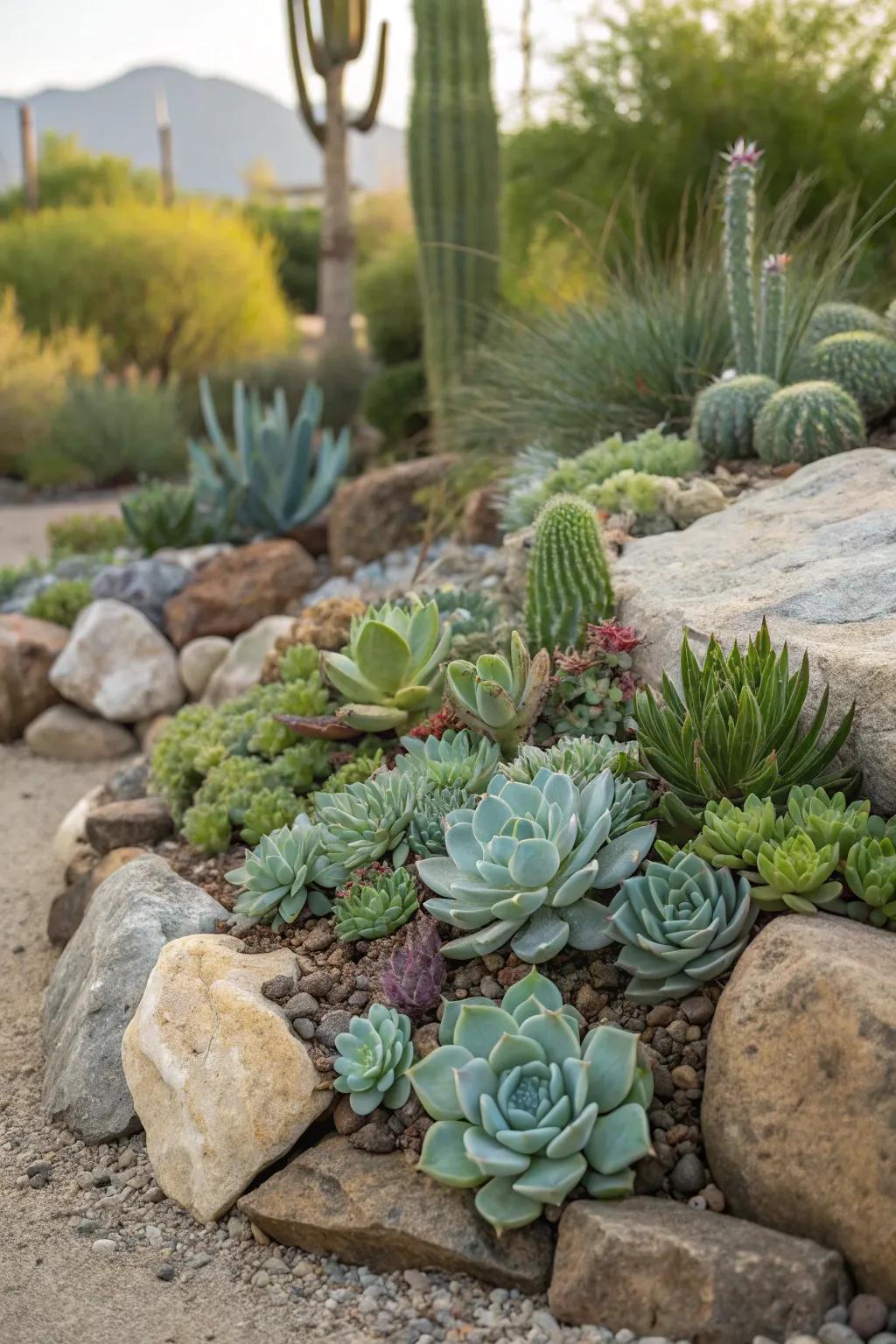
Create plant islands surrounded by rocks for a pop of greenery. I enjoy arranging these islands with colorful succulents in my garden for added interest.
Try these:
- Succulent Plant Collection: Enhance your garden with a variety of vibrant succulents, perfect for creating lush plant islands.
- Decorative Landscape Rocks: Transform your garden with decorative rocks, ideal for framing and accentuating plant islands.
- Cactus and Succulent Soil Mix: Ensure healthy growth with a soil mix designed specifically for cactus and succulents.
11. Layered Landscapes
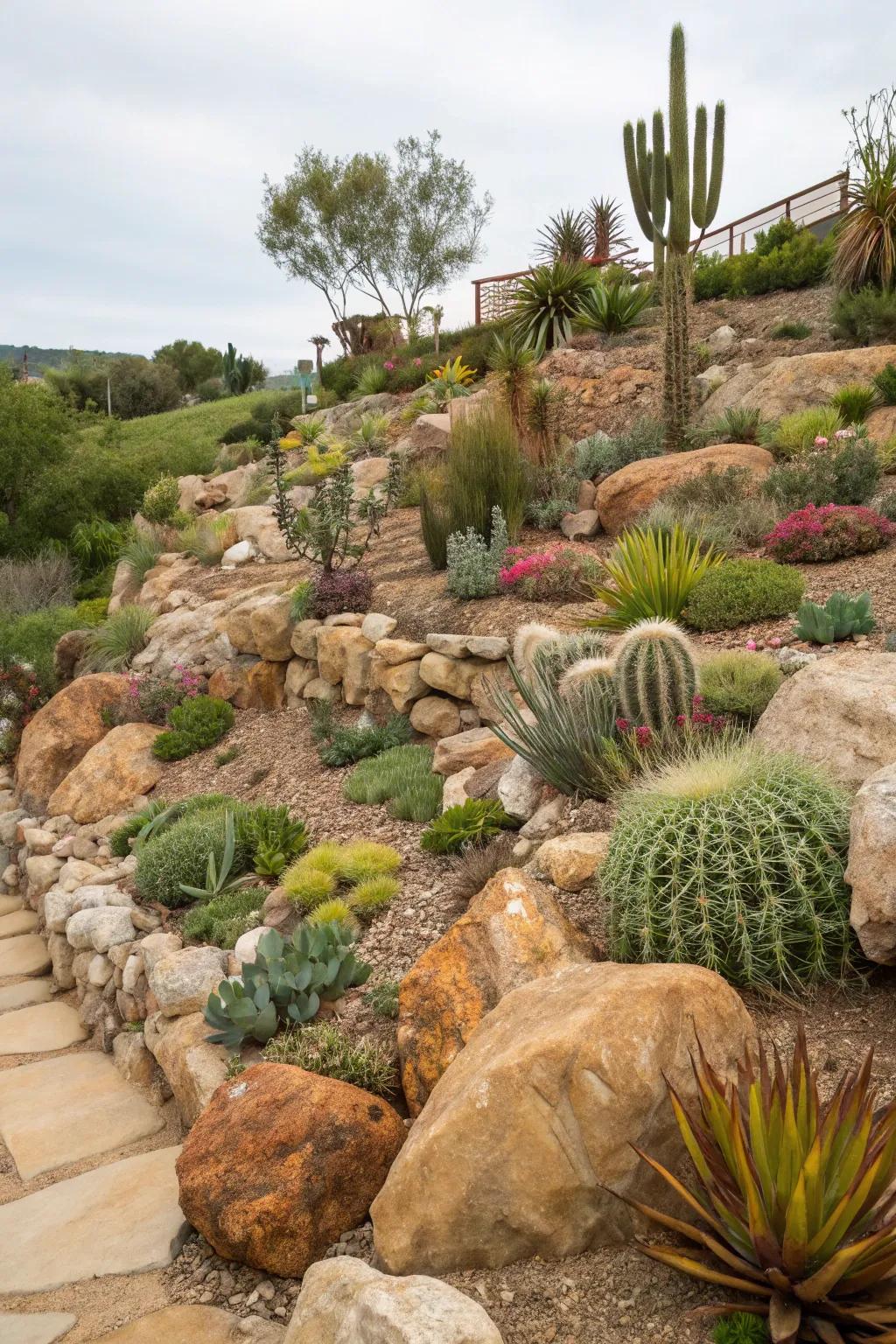
Creating layers with rocks and plants adds depth and dimension. In my garden, I’ve layered different heights of rocks to make a terraced effect that’s both functional and beautiful.
Might be a good match:
- Decorative Landscaping Rocks: Enhance your garden’s depth with versatile decorative rocks for striking layered landscapes.
- Succulent and Cactus Soil Mix: Ensure optimal growth for your xeriscape plants with nutrient-rich cactus soil mix.
- Garden Edging Stones: Create beautiful, defined layers in your garden with easy-to-install garden edging stones.
12. Rock Gardens
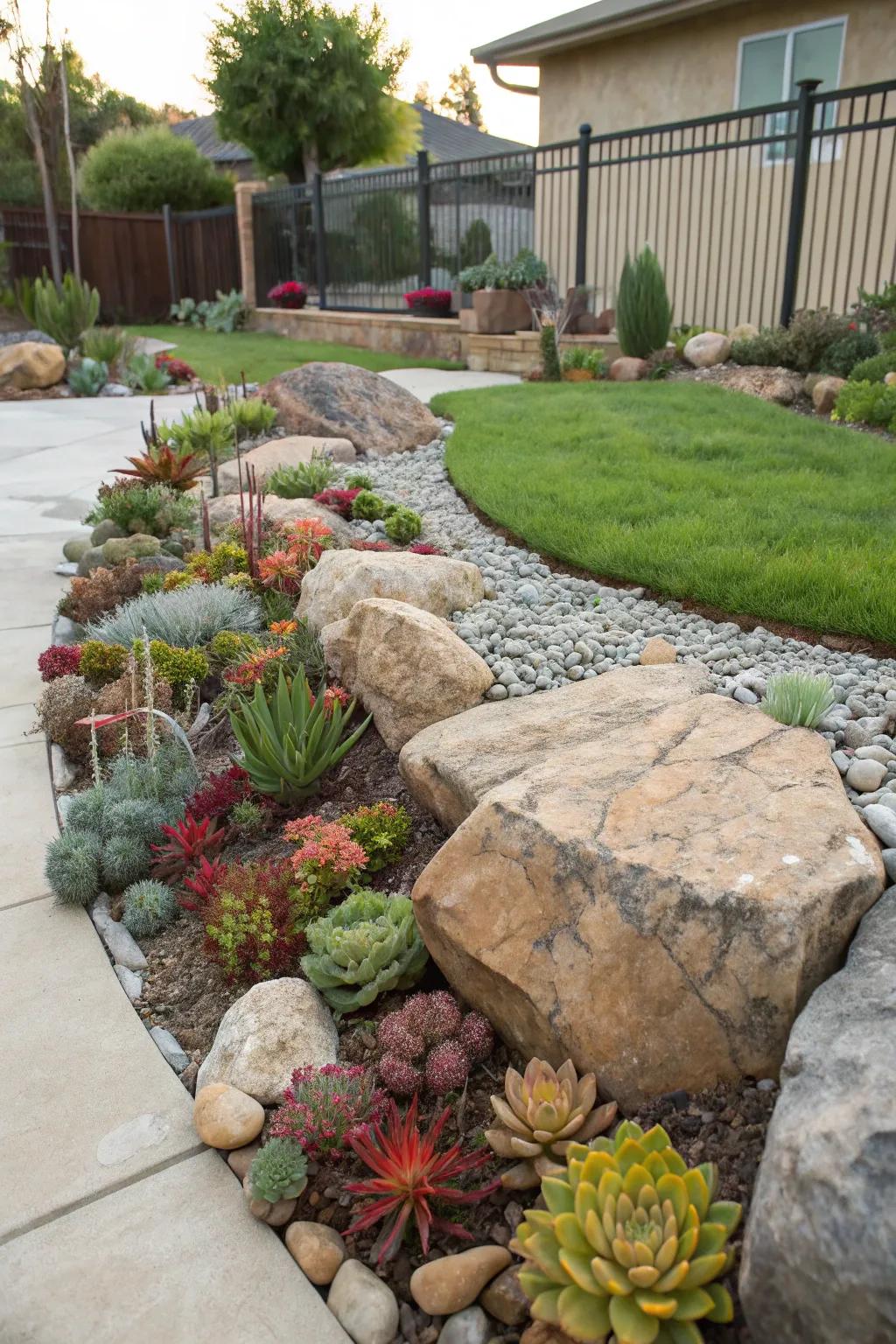
Rock gardens are a fantastic way to add texture and depth to your landscape. I love using a variety of rock sizes and colors to create a natural look that complements my succulents and wildflowers.
Check if these fit your needs:
- Decorative River Rocks: Enhance your garden with decorative river rocks, adding natural texture and contrast to your plants.
- Garden Succulent Collection: Brighten your rock garden with a vibrant succulent collection perfectly suited for dry environments.
- Landscape Fabric: Prevent weed growth in your rock garden with durable and eco-friendly landscape fabric.
13. Cactus and Rock Combinations
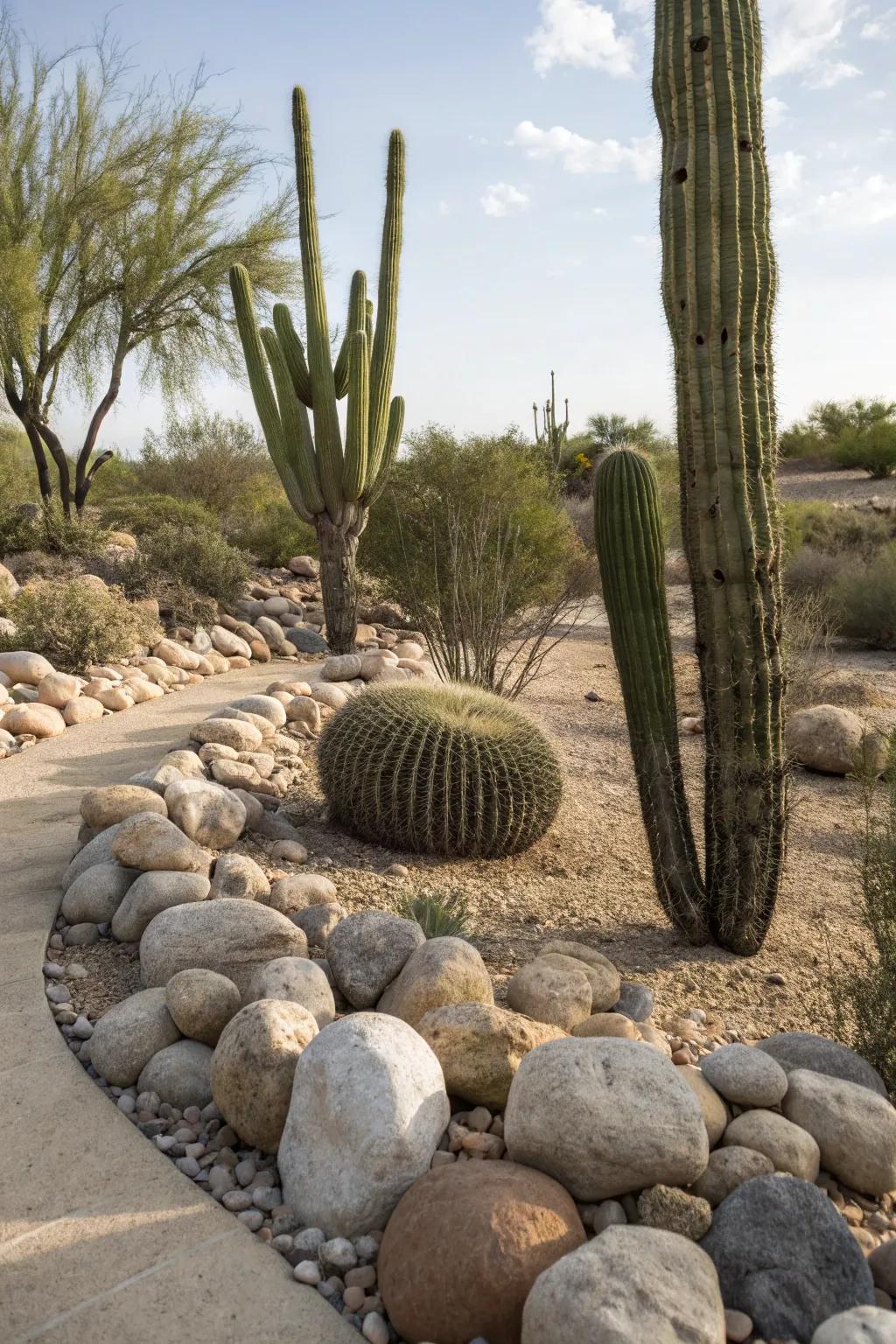
Pairing cacti with rocks creates a desert oasis vibe that’s both striking and low-maintenance. The bold shapes of cacti contrast beautifully with smooth stones.
Possibly helpful picks:
- Decorative River Rocks: Enhance your cactus garden with smooth river rocks for a serene, natural aesthetic.
- Live Cactus Variety Pack: Introduce diverse shapes and heights to your garden with a live cactus variety pack.
- Landscape Weed Barrier Fabric: Place weed barrier fabric to reduce maintenance and keep your cactus garden pristine.
14. Drought-Tolerant Plants
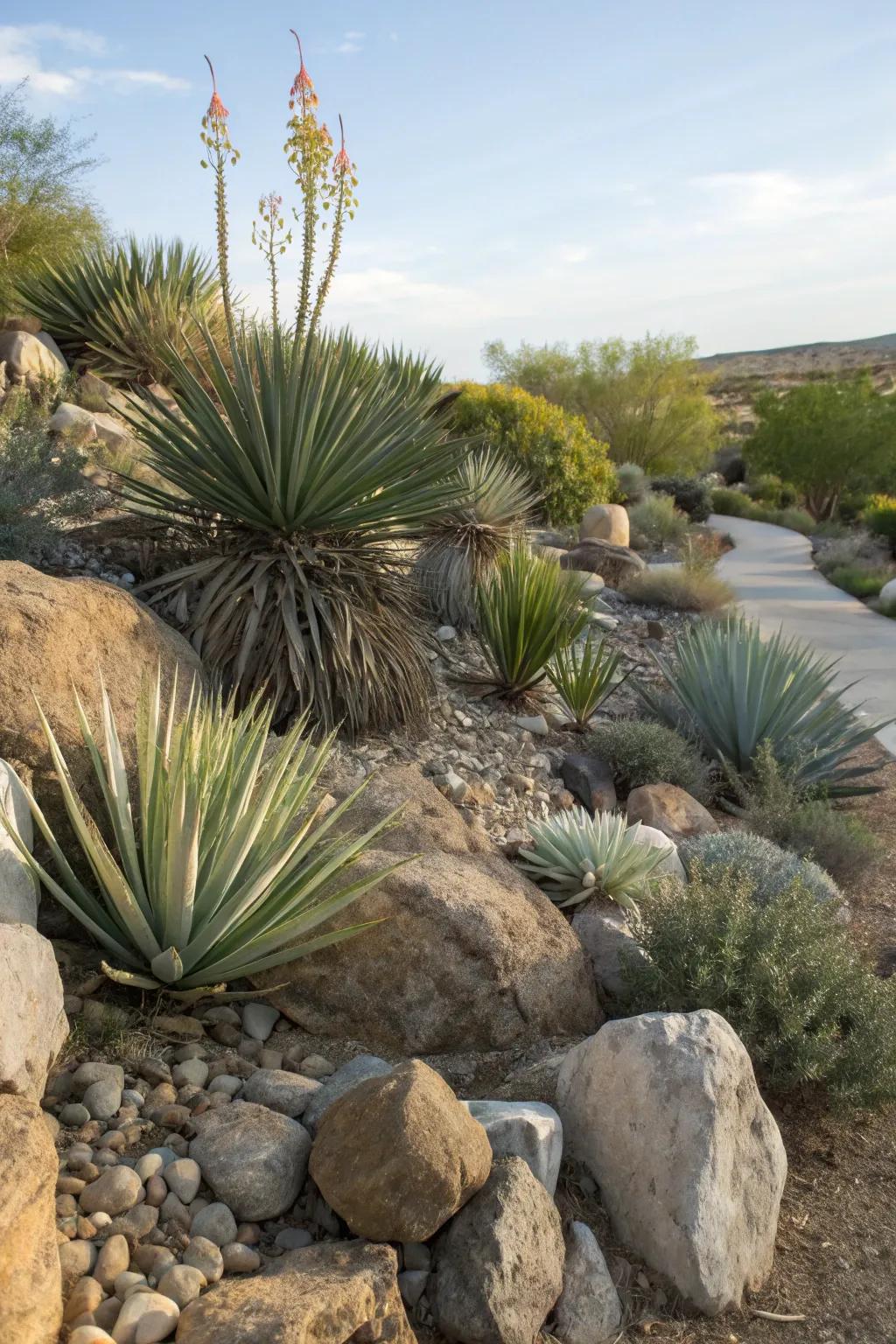
Incorporating drought-tolerant plants like succulents and ornamental grasses can drastically reduce water usage. My favorite combination is agave and yucca, which thrive in the rocky landscape.
A few choices to try:
- Agave and Yucca Plant Seeds: Bring life to your xeriscape with hardy agave and yucca seeds. Ideal for rocky gardens.
- Decorative Garden Pebbles: Enhance your xeriscape’s look with these natural pebbles, perfect for low-maintenance landscaping.
- Succulent Fertilizer: Ensure optimal growth for your succulents with this specialized fertilizer. Perfect for drought-prone areas.
15. Dry Riverbeds
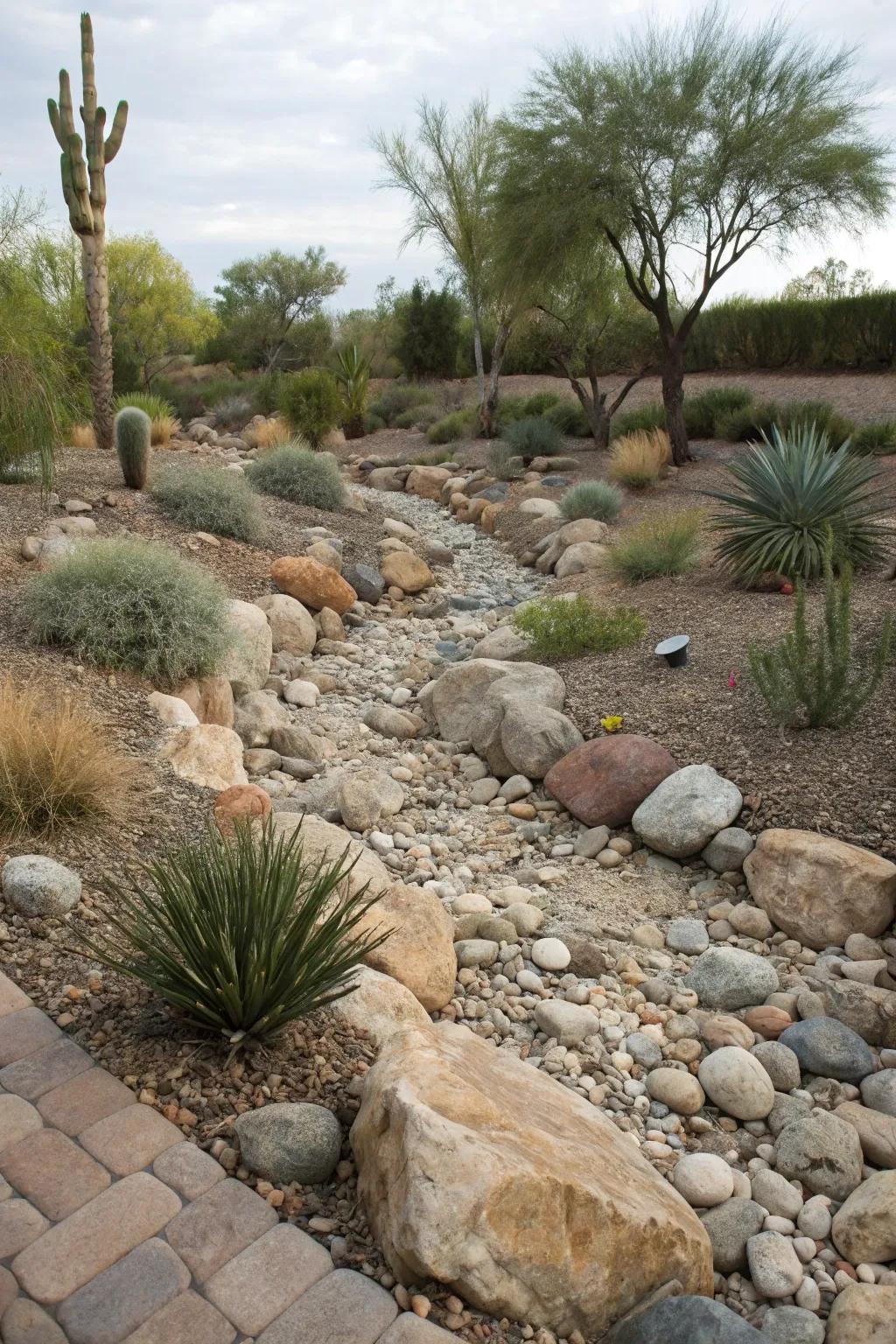
A dry riverbed can act as a natural drainage solution and a stunning focal point. I love using smooth river rocks to mimic the look of a flowing stream through my garden.
Products that could assist:
- Smooth River Rocks: Transform your garden with smooth river rocks for a realistic dry riverbed look.
- Landscape Fabric: Use landscape fabric to prevent weed growth and maintain the clean lines of your dry riverbed.
- Decorative Gravel: Enhance the texture and detail of your riverbed with decorative gravel varieties.
16. Artistic Touches
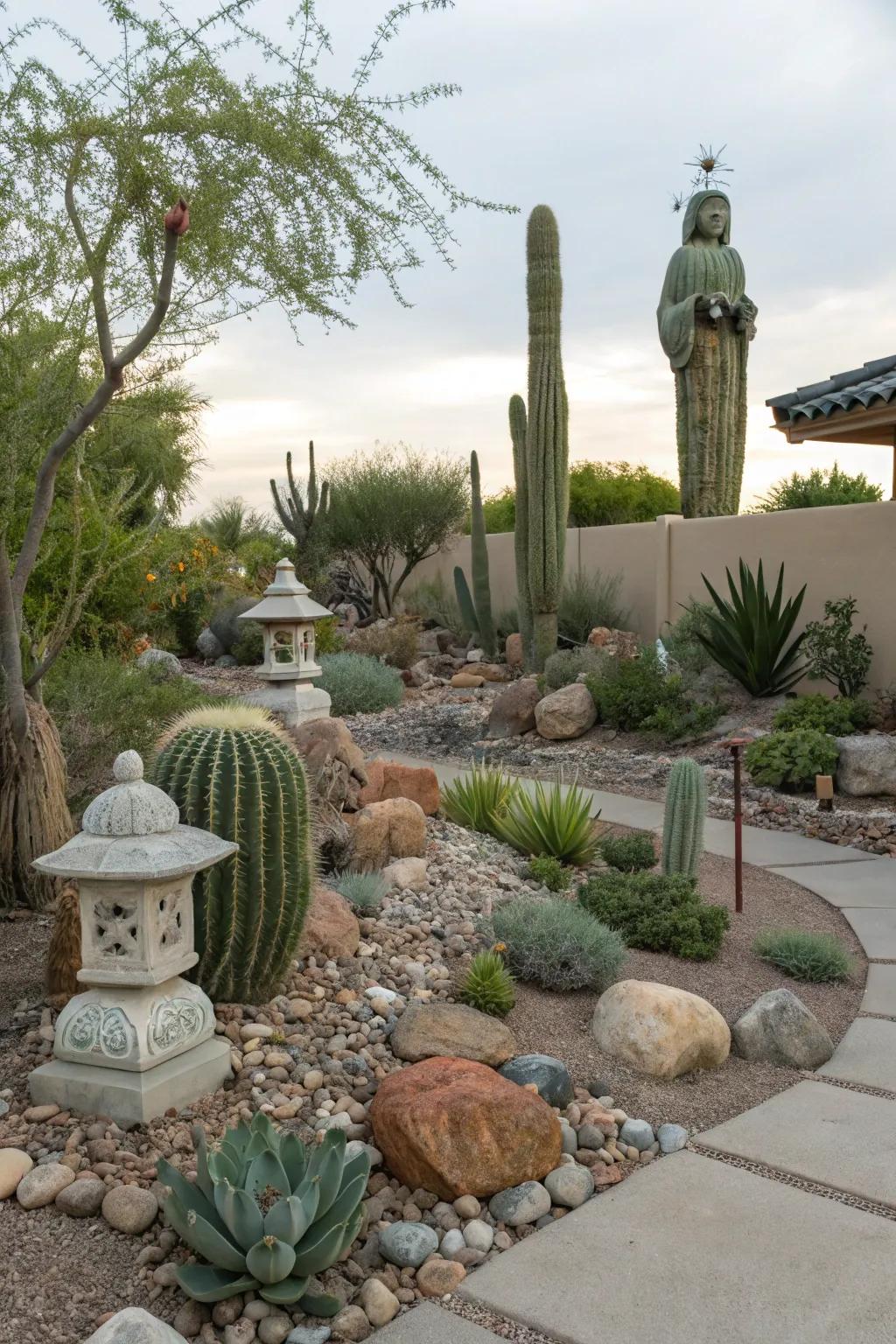
Adding artistic elements like sculptures or unique stones can personalize your garden. I have a few handpicked pebbles that create focal points and spark conversation.
Maybe worth checking out:
- Garden Sculptures: Enhance your xeriscape garden with stunning sculptures that add personality and charm.
- Decorative Pebbles: Create eye-catching focal points in your garden with unique decorative pebbles.
- Stone Lanterns: Illuminate pathways while adding artistic flair with elegant stone lanterns.
17. Rocky Sculptures

Create sculptures from stacked rocks for an artistic centerpiece. My favorite is a simple cairn that adds height and a focal point to my garden.
These products might be useful:
- Stackable Garden Rocks: Enhance your garden with versatile stackable rocks for creative and unique sculptures.
- Rock Sculpture Adhesive: Secure your rock sculptures with reliable adhesive, ensuring stability and longevity.
- Rock Sculpture Tools Set: Craft perfect sculptures with a complete set of tools designed for precision and creativity.
18. Surprising Rock Arrangements
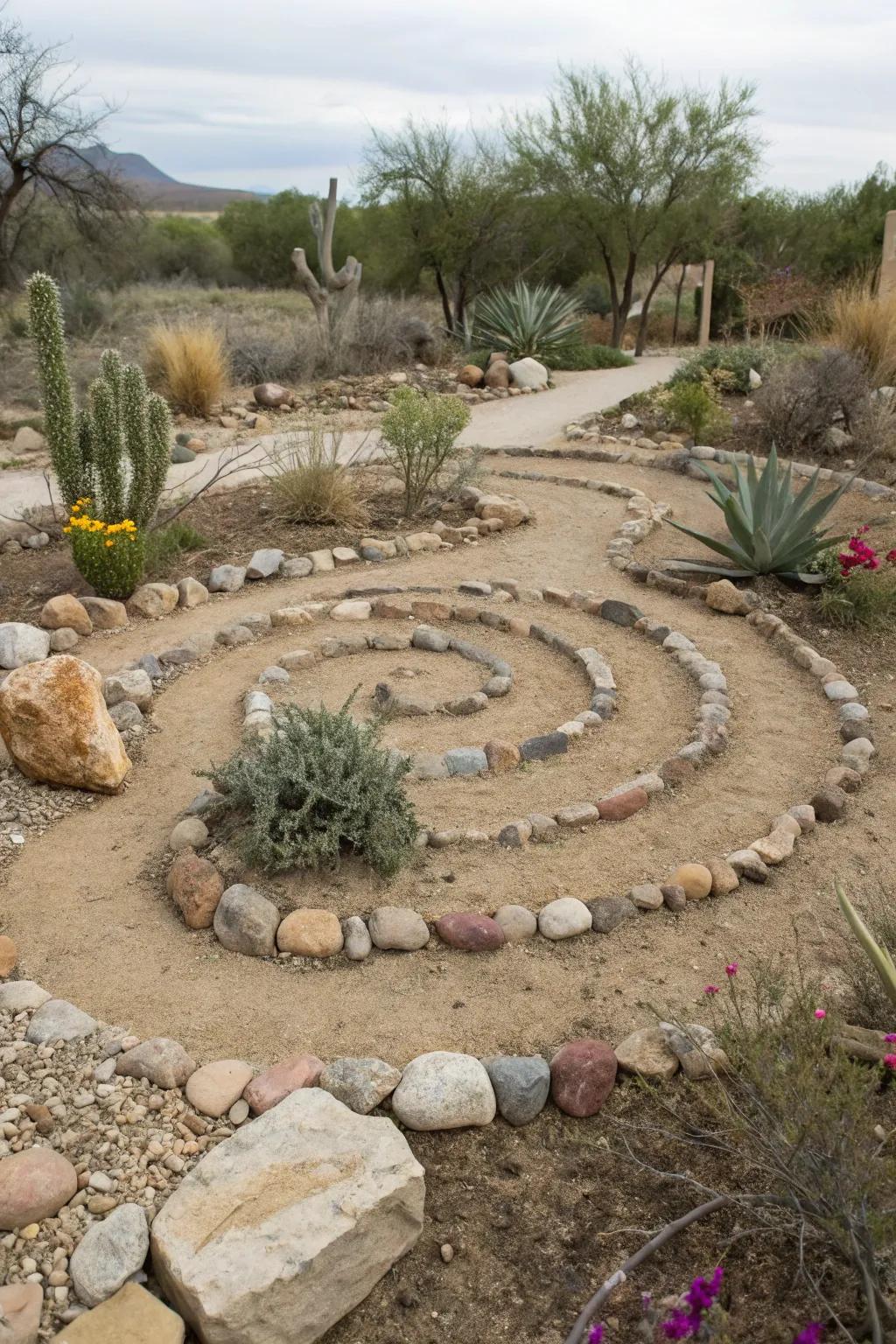
Try unexpected rock arrangements to catch the eye and break the monotony. In my garden, I have a spiral of stones that adds a whimsical touch.
Give these a look:
- Garden Decorative Stones: Enhance your xeriscape with natural stones to create striking spiral arrangements in your garden.
- Landscape Edging Kit: Define your garden spirals effectively and maintain structure with durable landscape edging kits.
- Xeriscape Plant Starter Set: Incorporate drought-resistant plants among your rock spirals for a lush yet water-wise garden design.
19. Pathways of Stone
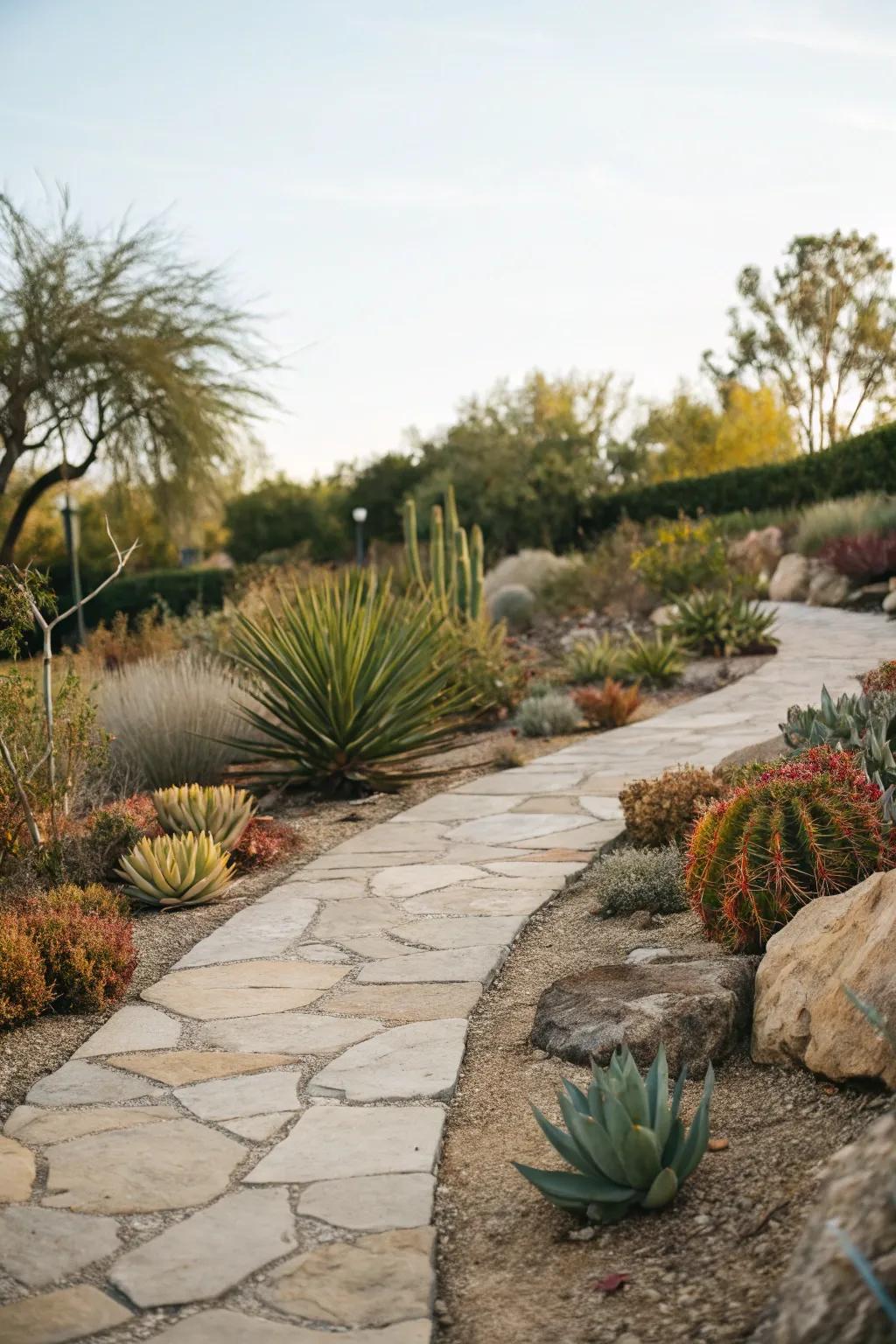
Creating winding stone pathways not only guides the eye but also enhances the flow of your garden. In my own yard, I’ve used large flat stones to create paths that naturally blend into the landscape.
A few relevant products:
- Large Flat Garden Stones: Create natural pathways by using these durable flat stones, adding rustic charm to your garden.
- Landscaping Fabric: Use landscaping fabric to prevent weeds and stabilize stones, ensuring a clean pathway experience.
- Garden Edging Stones: Define your pathways with durable edging stones to maintain structure and enhance visual appeal.
20. Vertical Rock Features
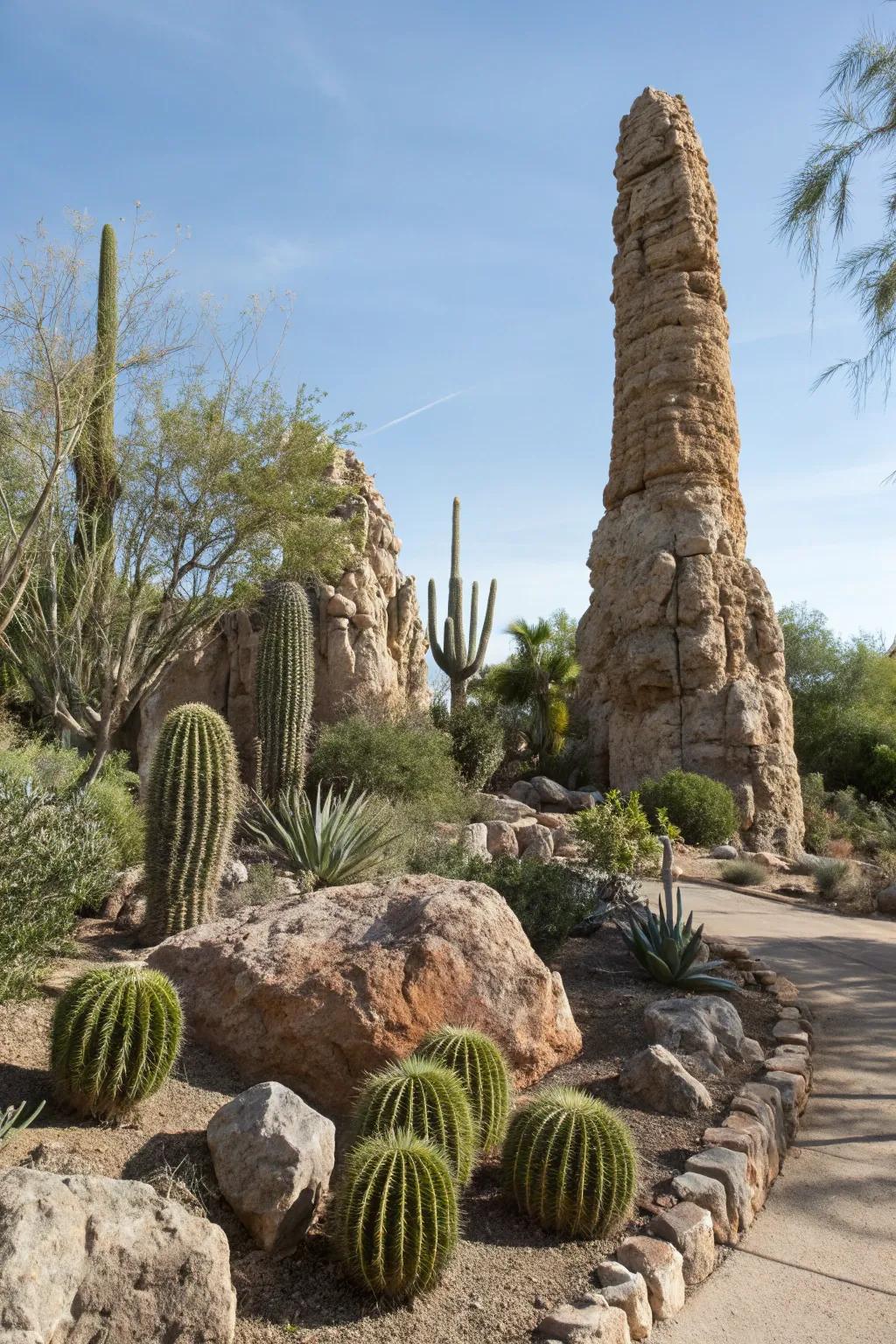
Incorporate vertical rock features to draw the eye upward and create interest. I have a few upright stones that serve as natural sculptures in my garden.
A few helpful options:
- Artificial Rock Sculptures: Elevate your garden design with easy-to-maintain artificial rock sculptures that draw the eye upward.
- Garden Stone Monoliths: Enhance your xeriscape with stunning stone monoliths that add height and intrigue to any space.
- Vertical Landscape Rocks: Transform your garden with vertical landscape rocks, adding dynamic natural beauty and vertical interest.
21. Zen Gardens
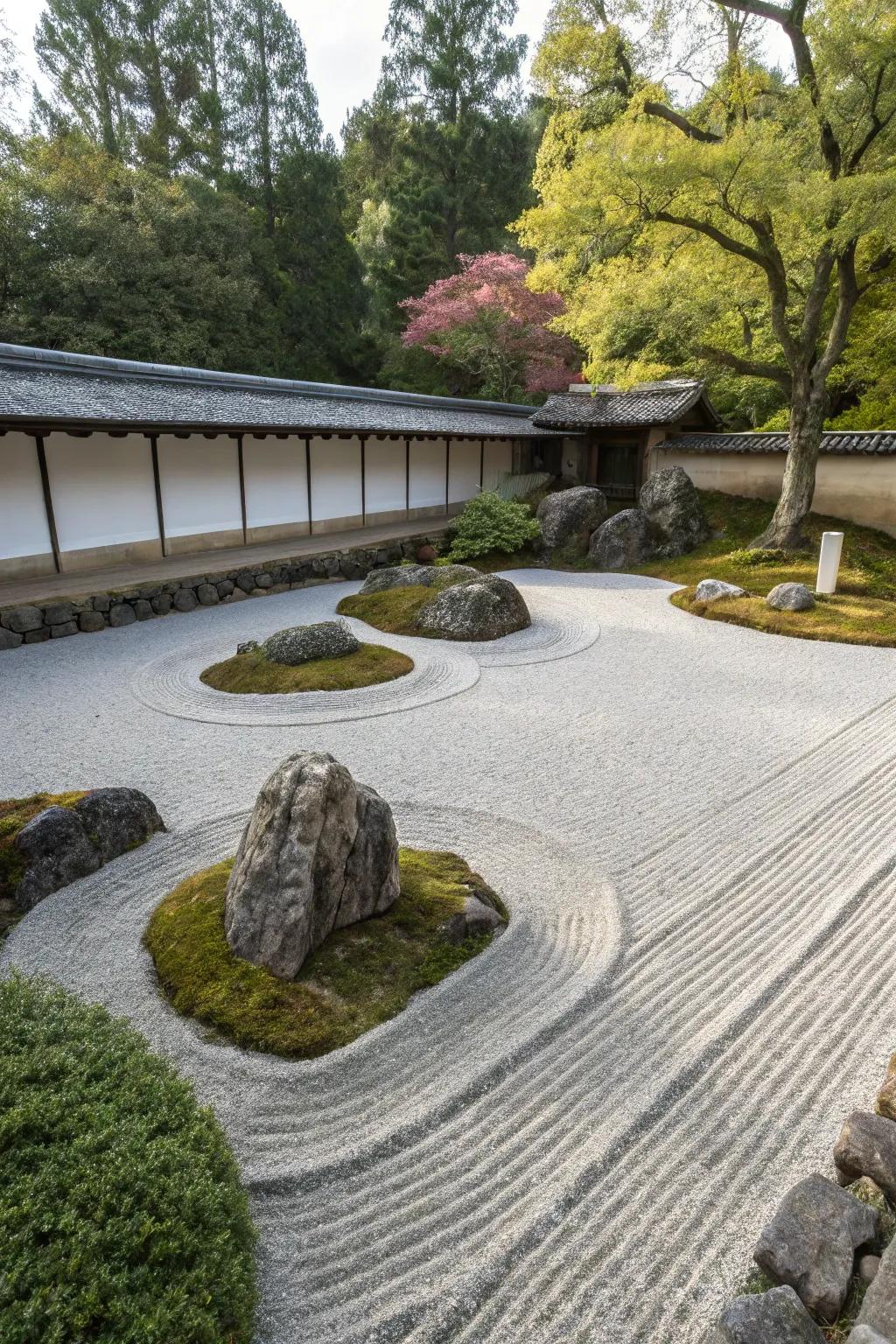
Bring peace and serenity with a zen garden using raked gravel and strategically placed rocks. I find this style perfect for creating a tranquil corner in my garden.
Items that may come in handy:
- Zen Garden Rake Set: Enhance your zen garden by creating beautiful patterns with this complete rake set.
- Decorative Garden Gravel: Achieve a tranquil look by adding decorative gravel, ideal for creating a calming space.
- Natural Landscaping Rocks: Elevate your garden’s aesthetic with natural rocks, perfect for serene and stylish landscaping.
